Understanding the Google Ads Auction
If you’re confused by Google Ads then we don’t blame you.
Despite the vast benefits that investing in a PPC campaign can bring to your business, if you’ve not explored this marketing avenue before, the ins and outs can seem confusing. At
Infoserve, we don’t think anyone should feel alienated by ‘in the know’ terminology, so we’ve broken down one of the most basic elements of Google Ads: the Google Ads Auction.
Because when
63% of people have clicked on a Google Ad (The Social Shepherd), how can you afford to miss out?
What is the Google Ads Auction?
When a user types a search query into the search engine, Google runs an auction. In essence, it analyses all of the ads that match the searcher’s keyword and spits out the most relevant ads and decides the order in which they appear.
This is determined by:
- Keyword relevance
- Landing page quality
- CPC (cost per click)
When setting up a Google Ad, companies will identify keywords they want to rank for and then set a maximum CPC bid.
How does the Google Ads Auction work?
Auctions begin when a user makes a search query on Google. If an ad is relevant for auction, it goes through the following process according to Google:
- When someone makes a search query, the Google Ads system finds all ads that match the search
- From this, Google removes the ads that aren’t appropriate for that search including location specific searches
- The ads that remain are then sorted according to which has the highest Ad Rank
Because the auction is repeated each time a new search query is made, every auction can have different results. Therefore, it’s normal for your ad to appear 1st one day and 2nd on another.
However, if your ad is more relevant and of higher quality then you may find yourself with a high CTR and conversion rate than a higher ranked ad.
The position of Ads also changes constantly. For example, as this blog goes live, Google shows 3 ads at the top of the search results and 3 at the bottom.
What is Ad Rank?
Ad Rank is a value used to determine where ads are shown in search results (ad position). It is calculated using:
- Bid value: Your cost per click as compared to other relevant ads
- Ad quality: Expected CTR, relevance to the query and landing page quality/experience
- Rank thresholds: The minimum bidding threshold for the ad
- Auction competitiveness: Volume and quality of other relevant ads
- Search context: Type of search query, location, device used, time of day, organic results attributed to the query and other relevant factors
- Expected impact of ad: How your ad is expected to perform. This could be based on landing page experience and previous performance
The ad with the highest Ad Rank will appear first in the search results, the second will appear second and so on.
How is ad rank calculated?
Ad rank is calculated by multiplying an ad’s quality score by the maximum PPC bid. This will take the above factors into consideration.
Therefore, ad quality and cost both impact each other. If you have a low budget but the quality and relevancy of your ad are high, you might still achieve a high Ad Rank score.
Minimum Ad Rank Threshold
For each auction, Google sets minimum reserve prices to determine whether an ad will be shown at all. This is to maintain the highest quality and relevancy of ads.
Thresholds are determined at the time of the auction with consideration for the following factors:
- Ad quality
- Ad position
- User signals i.e device type and location
- Search topic
- Search nature
- Related queries
Ad Ranks Thresholds impact your actual CPC:
According to Google: ‘If your ad is the only one that’s eligible to show, (for example, because none of your competitors meet their Ad Rank thresholds), you’ll pay the reserve price’.
What is CPC?
CPC (cost per click) bidding is a form of bidding where you pay for each click on your ads.
When you use CPC bidding campaigns you’ll set a maximum CPC which is the maximum you’re willing to pay for each click. This will be used to calculate your Ad Rank.
Although you set a maximum CPC, you are likely to be charged less per campaign, depending on the competitiveness of your keywords.
When setting your maximum CPC, you’ll have the choice between:
- Manual bidding: You choose your bid amounts
- Automatic bidding: Google sets your bids to maximise your overall budget
What is Quality Score?
Quality Score is a tool used to determine the overall quality of your ad compared to other Ads. It is ranked from 1-10.
Ads that are considered more relevant, user friendly and useful are given a higher Quality Score for the associated keyword.
Quality Score is determined by 3 main factors:
- Ad relevance: How closely your ad content matches the searcher’s query
- Landing page experience: How useful your landing page is to the user
- Expected click through rate: Predicted click through rate for your ad. This is determined by calculating number of clicks ÷ impressions
How to improve Quality Score
According to Google, the following strategies can improve your Quality Score performance:
1. Review your quality score components:
Discover insights into how to improve quality score by reviewing Expected CTR, Ad relevance and landing page experience. This will tell you where improvements need to be made such as ad text, keyword relevancy or even landing page flow.
You will be given a score of ‘average’, ‘above average’ or ‘below average’. Improve the lowest scoring areas first to bring your overall average up.
2. Make ads more relevant to your keywords
Try matching your ad text and landing page text more closely to your keywords. Including them directly within titles, headings and body text can drastically improve your relevancy to the query.
You could also split your ads into ad groups that rank for different, but related keywords that more closely resemble searcher’s queries.
3. Improve CTR
To improve CTR, try:
Editing ad text to something more engaging- Ensuring your ad matches the search intent
- Referencing the benefit of your product rather than its features
- A/B testing ads with different text and CTAs (call to actions)
- Improving specificity of ad text
4. Update your landing page
Give people what they’re looking for and make sure your landing page is optimised towards a single, specific CTA. Make sure the messaging aligns with your ad text and that all content is mobile friendly.
Still not sure where to start?
Infoserve’s dedicated PPC team exists to cut through the noise and make investing in PPC as simple as possible and our expert Web Design and Content Writing experts can create a targeted landing page that maximises conversions.
Increase your lead gen with
Infoserve PPC today and get £475 free managed ad credit.













